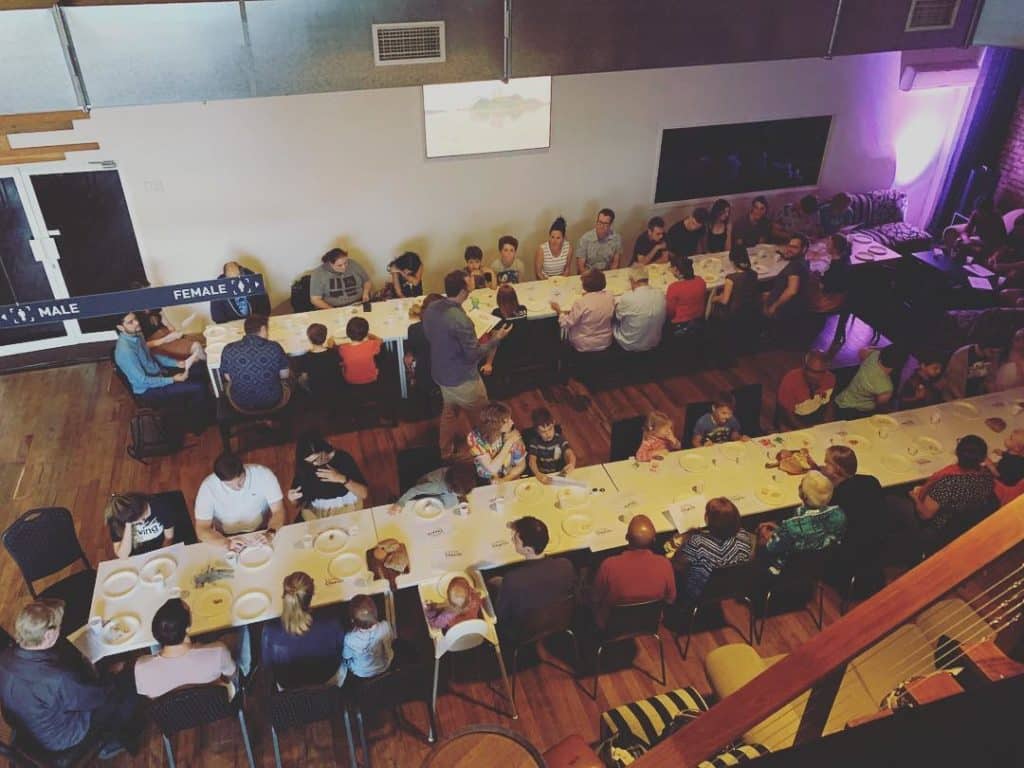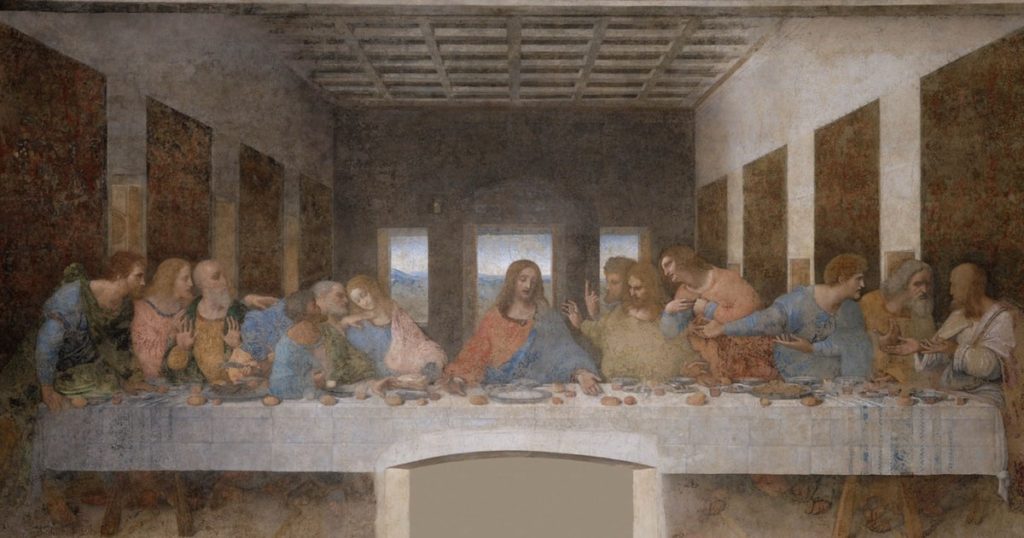The night before he died, the night he was betrayed, or today — the Thursday before Good Friday — Jesus gathered with his disciples to share the Passover. At Living Church City South we’ve started celebrating the Lord’s Supper (as we Presbyterians call it) as part of our mealtime together on the occasions that we share in it. Our practice of the Lord’s Supper has been developing over the five years we’ve gathered as a church. We eat together this way to learn that the Gospel is our story, and that as it becomes our story we become family, connected to God, and to one another.

The Lord’s Supper is held to mean different things in different theological traditions, different denominations have formed and fought over what is happening when we break bread and share wine (or grape juice), the different names for it — The Lord’s Supper, the Eucharist, Communion — carry different understandings of the significance or nature of the ‘sacrament’ we participate in as we carry out the command of Jesus to “do this in remembrance of me” (Luke 22:19). Whatever the theology behind the practice (and this is not to dismiss the importance of clarity on that question), the practice itself — sharing in the memory of the death and resurrection of Jesus together — has a certain sort of formative power as we do this together. Our actions shape us, our actions, where we are participating in a story, tell us who we are and what story we belong to; they’re part of developing our character and shaping our imagination. I’ve become more convinced by the importance of that power, and our practices, in recent years, and so more interested in the ‘form’ we adopt for sharing in the Lord’s Supper together because of what I think it is meant to form in us as we participate together. This is why we share the Lord’s Supper together as part of a meal, why last time we sat around tables, and why we invite children to participate in the meal with us (it’s also why we eat dinner together every week).
Other ‘forms’ that sharing the Lord’s Supper take also form our imagination, or our understanding of the story, in different ways. This is recognised in churches that share a common loaf and common cup, in churches that resist plastic wrapped ‘individual serves’ of communion bread and juice, in churches that practice or do not practice dipping the bread in the juice, and in church architecture — where the ‘correct’ placement of the table (with regards to the congregation, the pulpit, etc), the person or people distributing the elements, and whether the table is ‘fenced’ (literally), or not are all used to form people and their understanding of God, the Gospel, and the Church, via these decisions. For people from a ‘high church’ tradition, whether there’s ‘real presence’ or ‘transubstantiation’ happening in the elements or the event, or not, adopting particular forms (including physical postures) is about connecting one’s self, via words and actions (or liturgy) to the presence of God, and to other churches through space and time, following age old patterns that many others follow. I can recognise the beauty in that, though, by theological conviction and aesthetic preference, I’m not ‘high church.’ Our particular decision about the form we adopt for the Lord’s Supper in our church community is shaped by the sort of church community I believe the story of the Bible calls us to be, I hope, too, that as we participate in this sacrament we are recognising the connection we share, by God’s Spirit uniting us in Christ, with the church across space and time. I hope that our particular form is forming our imagination, teaching us the story we belong to, and reminding us who we are — I hope it is teaching us who we are in relationship to the people we share this meal with, but also helping us imagine the power of all our meals, or how we use our tables and homes as people formed by this story. I think there are many forms this meal can take while faithfully obeying the call of Jesus, and that they’ll be shaped by many different issues, but I’m also convinced that form and content work together to teach and train us; the medium is the message, or at least part of it. I’m hoping our particular form teaches us:
- That through the body and blood of Jesus given for us, and our sharing in it, we receive God’s Spirit which makes those of us who share in this meal together part of God’s family.
- That we are invited to this table — this meal — by God as an act of hospitality that breaks down the things we divide over, and that we come not just as forgiven sinners, but as those given new life in Christ, who is present in us, always, by his Spirit and who calls us to live generous and hospitable lives shaped by his rescuing us from Satan, sin, and death.
- That we now belong to God, but also, as the body of Christ, we belong to one another. That the Gospel is now our story to live and to tell together, as we are being transformed into the image of Jesus and called to proclaim his death and resurrection until he comes.
That’s a lot to be achieving in just one form, or one meal. But the act of eating a proper meal together, as a church family, and participating in the Lord’s Supper together as part of that meal (as part of our time together gathered as a church) is, I hope, helping to tangibly demonstrate these realities and to invite us to live as though they are true. I think it also has the benefit of being Biblically and sociologically exciting.
The Passover, the meal Jesus gathered to eat with his disciples on this Thursday, is a meal celebrated by people from the nation of Israel to celebrate God’s rescue of his people from slavery in Egypt. There are rules for sharing the Passover meal, the first time, recorded in Exodus 12. The people were to eat lamb; to make sure there was enough for everybody, if a house couldn’t buy a whole lamb they had to share with their neighbours (Exodus 12:3-5). They were to eat the meat roasted, and to serve it with herbs and unleavened bread (bread without yeast) (Exodus 12:8). And, they were to paint their doorframes with the blood of the lamb (Exodus 12:7). This was the mark that would ensure God ‘passed over them’ as he judged the Egyptians. Exodus, which records these events after the fact, comes not just with the story of the first Passover, but the command to celebrate the meal as a festival every year from that point, a ‘lasting ordinance’ commemorating their rescue (Exodus 12:14-20), and that it marked them as God’s kingdom, his nation, his people. Kids were involved in this meal — it was a festival, a feast, that taught them their story; who they are; who they belong to.
“When you enter the land that the Lord will give you as he promised, observe this ceremony. And when your children ask you, ‘What does this ceremony mean to you?’ then tell them, ‘It is the Passover sacrifice to the Lord, who passed over the houses of the Israelites in Egypt and spared our homes when he struck down the Egyptians.’” — Exodus 12:25-27
Children participated in the meal as part of the family of God; at Living Church we share in the Lord’s Supper eight times a year, at least half those times we invite kids to be not just witnesses to, or partakers of, but participants in the action. Instead of a ‘priestly’ preacher reciting some formula, we have the children ask the adults ‘why are we doing this’ (with the answer guided by the particular passage we’re looking at, which in recent times has been the last supper in Luke’s Gospel). Luke has what appears to be a peculiar relationship with food. He’s obsessed with meals. Jesus eats with all sorts of people, and has all sorts of conversations around all sorts of tables before he shares the last supper with his disciples. On one notable occasion he talks about how we should approach our own tables — and who we invite to eat with us, in a nice piece of foreshadowing how his instructions on the night before he dies might make meals together a really significant way to teach us who we are…
“When you give a luncheon or dinner, do not invite your friends, your brothers or sisters, your relatives, or your rich neighbors; if you do, they may invite you back and so you will be repaid. But when you give a banquet, invite the poor, the crippled, the lame, the blind, and you will be blessed. Although they cannot repay you, you will be repaid at the resurrection of the righteous.”
When one of those at the table with him heard this, he said to Jesus, “Blessed is the one who will eat at the feast in the kingdom of God.” — Luke 14:12-15
When Jesus hosts a meal, as a picture of ‘the feast in the kingdom of God,’ he invites everyone; and he invites us not as ‘other’ as poor outsiders in need of charity, he invites first the disciples, and then us to be his family, sharing at the table in the kingdom of heaven (Luke 22:30).
In the first account of the church following the command of Jesus to remember him through the breaking of bread — in Acts 2 — participating in this act of eating together is something that happens in houses — presumably as ‘households’ (including children) and increasingly as a sort of ‘spiritual family’ — “all the believers” were meeting daily in the temple, and meeting in homes where they ‘broke bread’ and ‘ate together’ (Acts 2:42-47).
Eating together has always been a powerful social action; it isn’t just about slamming nutrients down in proximity, but sharing a table with another person carries a certain sort of symbolic and formative power. The Jews had laws about eating with one another, and not sharing meals with gentiles (or the contexts where it was ok); in the first century the saying wouldn’t have been “you are what you eat” but “you are who you eat with” — this is why when Gentiles, with no food laws, start becoming Christians later in Acts, the rules for life together as Christians involve eating rules (Acts 15). If you wanted to teach people in the first century that no matter what their background, or status, or age, or stage — they were family — the way to do that would be to have them eat together; especially in a home. There were also lots of public meals, feasts, and festivals in both the Jewish and Roman worlds that taught people the story they belonged to. Here, in the breaking of bread remembering the body of Jesus, is the story of the church. A more recent thinker, anthropologist, Mary Douglas, wrote an essay ‘Deciphering a Meal’ examining the social symbolism of different meals; she says the point at which we sit at a table and eat hot food together is the point where we’ve moved from acquaintance to friend to family. She says:
“Meals are for family, close friends, honored guests. The grand operator of the system is the line between intimacy and distance. Those we know at meals we also know at drinks. The meal expresses close friendship. Those we only know at drinks we know less intimately… those friends who have never had a hot meal in our home have presumably another threshold of intimacy to cross.”
It’s interesting to ponder how space, or architecture, really is part of the ‘form’ or the ‘forming power’ of the things we do together; and to ponder what is gained or lost by ‘breaking bread’ together in large quasi-public spaces, rather than our homes, if the home, in the New Testament church, was part of what reinforced the new reality, that in Christ we are family, and, recognising the impact of space or architecture ask what we might do with our practices to reinforce this truth. This is why we’re increasingly incorporating the Lord’s Supper into our ‘dinner time’ at church, and why sitting at tables together felt revolutionary. It’s also why I, personally, find the ‘high church’ architecture, which makes much of the priest and the space of the altar, counter-formative when it comes to the substance, or message, of the sacrament. The altar alters the space, and so the form, of the meal; imagine if Da Vinci’s famous painting of The Last Supper had Jesus standing behind an altar, rather than sitting with his friends-becoming-family…

It’s possible for de-formation to happen in the context of the house, and the meal, too. This isn’t a fix-all. When the apostle Paul writes to the church in Corinth to correct their approach to the sacramental meal, he writes because the form of their meal is undermining the substance, or message, and more than that, is undermining who they are. The Corinthians appear to be sharing in the Lord’s Supper as part of a meal together in homes; but, the way they are sharing in a meal is symbolically more like a status-boosting first century meal (the type the Pharisees were throwing in Luke’s Gospel, and that patrons in the Graeco-Roman world would throw). They’re giving places of honour to the rich and powerful members of the church — who’d eat first — and leaving others to go hungry, others are gorging themselves and not ensuring everyone gets fed (1 Corinthians 11:21-22). Paul says when they do this “it is not the Lord’s supper that you eat” (1 Corinthians 11:20); he reminds them of the substance of the Supper and what it is supposed to do; firstly he repeats Jesus’ words and instructions we saw from Luke’s Gospel, and then he says: “For whenever you eat this bread and drink this cup, you proclaim the Lord’s death until he comes” (1 Corinthians 11:26). The Lord’s Supper, this meal, proclaims the Gospel. Just as the Passover meal did for Israel. It’s a strange and anachronistic thing for us to imagine that these family meals only featured adults, that they weren’t chaotic affairs with kids running around and participating in family life — often we argue from silence about the way children participated in the life of the church (Paul is happy to write instructions in his letters that address them directly though, as though they’re part of the action). The way the Corinthians are eating together is undermining this proclamation; his solution is twofold — first they’re to remember what they’re on about, he says: “For those who eat and drink without discerning the body of Christ eat and drink judgment on themselves” (1 Corinthians 11:29), and while part of this act of discernment must certainly be about remembering what is to be remembered, where he goes in chapter 12 with ‘the body of Christ’ would suggest that part of the act of discernment is remembering who they are; that the church is the body of Christ and to act otherwise tears that body asunder. The second instruction that aims to correct what is deforming the church as it misrepresents the Gospel is “all eat together” (1 Corinthians 11:33); this isn’t so much about simultaneous swallowing as about not having the rich and powerful eat the choice bits, and everyone else getting the leftover dregs; it’s about eating being an expression of unity; of togetherness; of communion with one another, and with God. Paul’s message to the Corinthians, from the beginning of the letter, has been that in Christ they’ve become ‘brothers and sisters’ — family — and they should live like it, but more than that, as they’re reminded by the Lord’s Supper, when they live a particular vision of unity, participating in ‘the body of Jesus’ as they eat, they (and we) are together ‘the body of Jesus’ proclaiming that unity and the Gospel until he returns.
Just as a body, though one, has many parts, but all its many parts form one body, so it is with Christ. For we were all baptized by one Spirit so as to form one body—whether Jews or Gentiles, slave or free—and we were all given the one Spirit to drink
When we eat together, especially when we celebrate the Lord’s Supper together, we’re teaching ourselves the Gospel; we’re teaching ourselves that we have been rescued; that we are God’s chosen people; that the Spirit unites us to each other as it unites us to Jesus; that we are family. It’s a great thing when our forms support that; when our ‘medium is our message’ — that’s why we’re sharing the Lord’s Supper the way we are at Living Church City South, and why each of our campuses is exploring different forms that reinforce this truth, so we can proclaim the Gospel together until Jesus comes.

